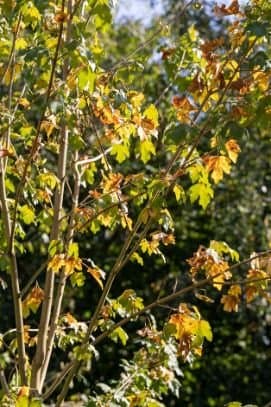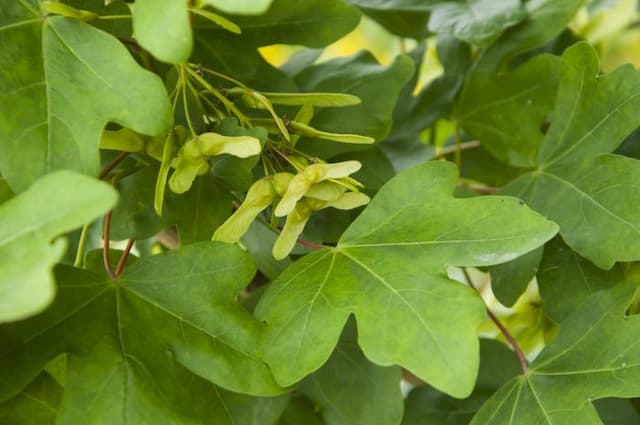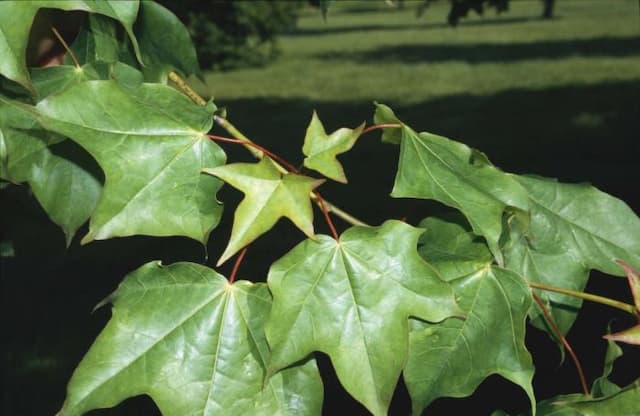Fullmoon maple Acer japonicum 'Aconitifolium'

ABOUT
The plant in question, commonly known as the Full Moon Maple, is known for its striking leaves that resemble the deeply lobed shape of aconitum or monkshood foliage. The leaves are intricately dissected, giving a feathery appearance and are arranged in a pleasing, rounded canopy. The Full Moon Maple produces leaves with a vibrant green color during the growing season, which undergo a dramatic transformation in autumn. As the colder months approach, the foliage adopts spectacular hues of red, orange, and purple, showcasing a breathtaking fall display. The Full Moon Maple blooms in the spring and is adorned with modest, pendulous clusters of reddish-purple flowers, which are typically followed by the development of winged seed pods known as samaras. These seeds, resembling tiny helicopters, mature over the summer and provide additional ornamental value with their interesting shape and contrasting colors against the foliage. Overall, the Full Moon Maple is cherished for its distinctive leaf shape and its remarkable seasonal color changes, making it a beloved feature in many gardens for its ornamental qualities.
About this plant
 Names
NamesSynonyms
Fernleaf Full Moon Maple, Fernleaf Japanese Maple, Full Moon Maple
Common names
Acer japonicum 'Aconitifolium'.
 Toxicity
ToxicityTo humans
The plant commonly known as the Fullmoon maple is generally not considered toxic to humans. There are no widespread reports of poisoning or toxic reactions from ingesting parts of this plant. Therefore, it is considered safe in regard to human toxicity. However, as with consuming any non-culinary plant or unknown substances, it is prudent to be cautious and avoid ingestion to prevent any potential adverse reactions.
To pets
The Fullmoon maple is not typically known to be toxic to pets. There is no substantial evidence to suggest that pets would suffer from poisoning upon ingesting parts of this plant. It is not listed among the plants that are commonly known to be poisonous to pets such as dogs and cats. However, it is always a good practice to monitor pets and prevent them from consuming non-food plants, as individual reactions can vary and some animals might experience gastrointestinal upset or other mild symptoms if they ingest plant material.
 Characteristics
CharacteristicsLife cycle
Perennials
Foliage type
Deciduous
Color of leaves
Green
Flower color
Purple
Height
15-25 feet (4.5-7.6 meters)
Spread
15-25 feet (4.5-7.6 meters)
Plant type
Tree
Hardiness zones
5-7
Native area
Japan
Benefits
 General Benefits
General Benefits- Ornamental Value: Acer japonicum 'Aconitifolium', commonly known as Fullmoon maple, has a unique leaf shape and vibrant fall colors that add visual interest to gardens and landscapes.
- Shade Provider: The canopy of the Fullmoon maple creates a cool, shaded area beneath it which can be beneficial during hot summer months.
- Ecosystem Support: Fullmoon maple provides habitat and food for various bird species and pollinators when it flowers.
- Seasonal Interest: Offers year-round interest with its spring flowers, lush summer foliage, striking autumn colors, and sometimes interesting bark patterns in winter.
- Hardiness: Exhibits good cold tolerance, making it suitable for a variety of climates and less susceptible to damage from frost.
- Small Stature: Due to its relatively small size compared to other maples, it is suitable for smaller gardens or areas with limited space.
 Medical Properties
Medical PropertiesThis plant is not used for medical purposes.
 Air-purifying Qualities
Air-purifying QualitiesThis plant is not specifically known for air purifying qualities.
 Other Uses
Other Uses- Photography and art subjects: The Japanese maple 'Aconitifolium' with its beautiful foliage and form serves as an excellent subject for photography and botanical illustrations.
- Bonsai cultivation: The intricate branch structure and stunning leaf color of 'Aconitifolium' make it a popular choice for bonsai enthusiasts.
- Seasonal celebrations: In Japan, the changing leaves of the Japanese maple are celebrated during autumn-viewing festivals called “momijigari”.
- Natural shade provider: The dense canopy of 'Aconitifolium' offers a cool, shaded area suitable for relaxing or for protecting shade-loving plants.
- Wildlife habitat: The tree provides shelter and the winged seeds serve as food for various bird species.
- Educational tool: 'Aconitifolium' can be used to educate students and gardeners about plant biology, especially regarding leaf shapes and seasonal changes.
- Architectural inspiration: The intricate leaf patterns and branch structures of the tree can inspire designs in architecture and decorative arts.
- Feng Shui: In some cultures, the Japanese maple is used in Feng Shui practices as a symbol of peace and balance.
- Culinary display: Its leaves can be used as a decorative element in plating and presentation of gourmet dishes.
- Crafts and ornamentation: Dried leaves and seeds of 'Aconitifolium' can be used in crafting ornaments or for decorative purposes in various artworks.
Interesting Facts
 Feng Shui
Feng ShuiThe Fullmoon Maple is not used in Feng Shui practice.
 Zodiac Sign Compitability
Zodiac Sign CompitabilityThe Fullmoon Maple is not used in astrology practice.
 Plant Symbolism
Plant Symbolism- Endurance and Strength: The Acer japonicum 'Aconitifolium', commonly known as the Fullmoon Maple, is a hardy species, symbolizing the ability to withstand various conditions and challenges.
- Peace: Trees in general often symbolize peace, and the calming effect of the Fullmoon Maple's beautiful foliage contributes to this symbolism.
- Beauty: With its delicate and intricate leaves that change color through the seasons, the Fullmoon Maple represents the aesthetic beauty of nature.
- Timelessness: As a species that can live for many years, the Fullmoon Maple represents longevity and timelessness.
- Grace: The elegant shape and movement of the Fullmoon Maple's leaves in the breeze symbolize grace and elegance.
 Water
WaterThe Full Moon Maple should be watered deeply once a week during its growing season, ensuring that the soil is moist but not waterlogged. Depending on the climate and weather conditions, this usually equates to about 1.5 gallons per week for a young tree. During the hot summer months, watering frequency may need to be increased to twice a week, and during periods of heavy rainfall, it can be reduced. During winter, water sparingly, just enough to prevent the soil from drying out completely, which may mean reducing water to a half gallon every two weeks, depending on local weather.
 Light
LightThe Full Moon Maple thrives in partial shade to full sun. Ideally, it should be planted in a location that receives morning sunlight and is protected from the harsh afternoon sun, which can scorch the leaves. Dappled sunlight is perfect for this maple, as it mimics the tree’s natural habitat beneath the forest canopy.
 Temperature
TemperatureThe Full Moon Maple is hardy and can withstand a range of temperatures; it can survive in temperatures as low as -20°F and as high as 80°F. The ideal growing conditions, however, are between 60°F and 75°F. This plant does not tolerate extreme heat well, so in areas where temperatures routinely soar above 80°F, it should be planted in a spot that receives shade during the hottest part of the day.
 Pruning
PruningPruning the Full Moon Maple is typically done for aesthetic shaping and to remove any dead or damaged branches. The best time to prune is during late winter or early fall when the tree is dormant. Pruning should be done sparingly, as the tree does not require it to thrive and excessive pruning can cause harm. Light trimming once every 2-3 years should be sufficient to maintain its shape and health.
 Cleaning
CleaningAs needed
 Soil
SoilFull Moon Maple prefers a well-draining soil mix rich in organic matter. A mixture of loam, peat, and sharp sand is ideal, ensuring good aeration and moisture retention. The soil pH should be slightly acidic to neutral, ranging between 5.5 and 7.5. Amending the soil with compost or leaf mold can enhance its structure and fertility, conducive to the plant's growth.
 Repotting
RepottingFull Moon Maples should be repotted approximately every 2-4 years, or when they become root-bound. Younger trees may require more frequent repotting due to their faster growth rate, whereas mature trees can be repotted less often as their growth slows.
 Humidity & Misting
Humidity & MistingFull Moon Maple thrives best in moderate to high humidity levels. It prefers an environment with around 60-80% humidity. If the air is too dry, especially indoors, the plant’s foliage may develop brown edges.
 Suitable locations
Suitable locationsIndoor
Ensure bright, indirect light and humidity.
Outdoor
Plant in partial shade; shelter from strong winds.
Hardiness zone
5-7 USDA
 Life cycle
Life cycleAcer japonicum 'Aconitifolium', commonly known as the Fullmoon Maple, begins its life cycle as a seed, which after stratification (a period of cold to break dormancy), germinates in the spring. The seedling then emerges and establishes itself, developing into a juvenile plant with the iconic dissected foliage that deepens in color from green to red or orange in the fall. As it matures, the Fullmoon Maple grows into a small tree or large shrub, typically reaching its mature size in 10 to 15 years. During this time, it experiences seasonal cycles of growth in the spring and summer, followed by dormancy in the fall and winter. Once fully mature, it produces flowers in spring, which after pollination, develop into samaras (winged seeds) that disperse by wind. This tree may live for several decades, continuing the cycle by producing seeds every year, which fall to the ground and have the potential to grow into new plants.
 Propogation
PropogationPropogation time
Late summer
Propogation: The Japanese Maple 'Aconitifolium' is most popularly propagated using the method of grafting, particularly during the late winter or early spring before the plant breaks dormancy. In grafting, a piece of a stem with leaf buds, known as a scion, is inserted into a stock tree, which is typically a seedling or clone with a strong root system. The scion and stock need to be firmly bound together until the graft union heals and the tissues fuse, which typically takes several weeks to a few months depending on conditions such as temperature and humidity. Grafting not only combines the desirable characteristics of the 'Aconitifolium' foliage with a robust rootstock but also ensures a clone of the parent plant, maintaining the exact traits for which this cultivar is valued. The process requires skill and practice to be successful, as the cut surfaces need to be made cleanly and aligned properly to ensure a good union between the scion and the rootstock.







![Freeman maple [Autumn Blaze]](/_next/image?url=https%3A%2F%2Fplants-admin.emdemapps.com%2Fimages%2Fplants%2F%2Fimages%2F604b575b84d87.png&w=640&q=75)

